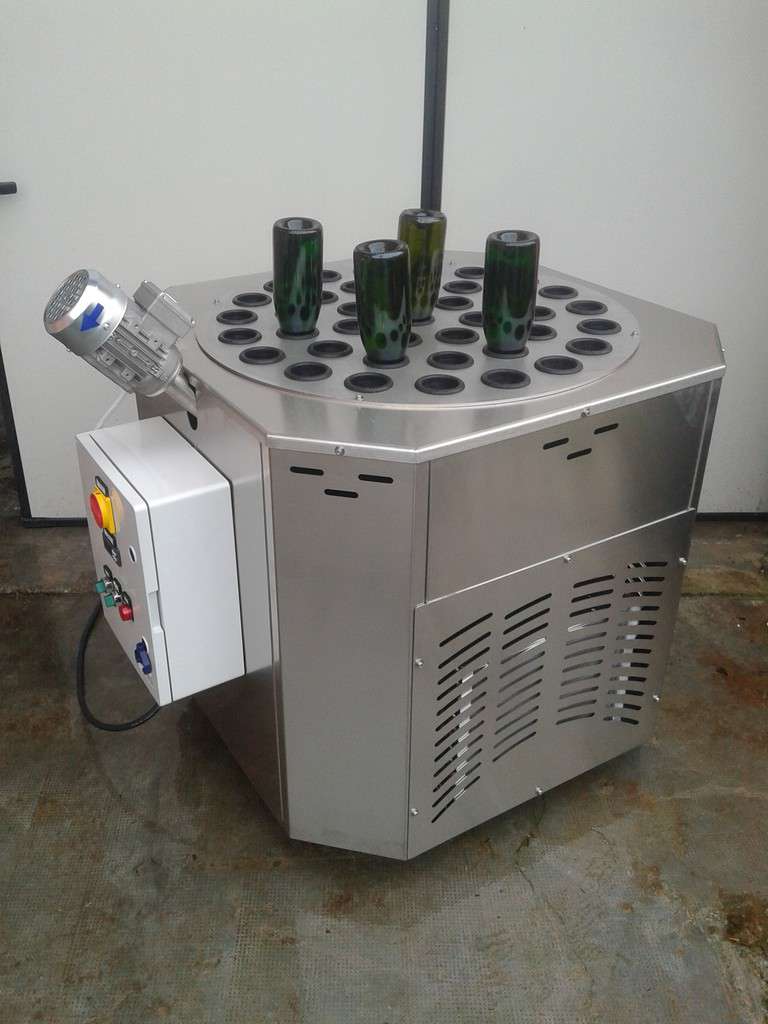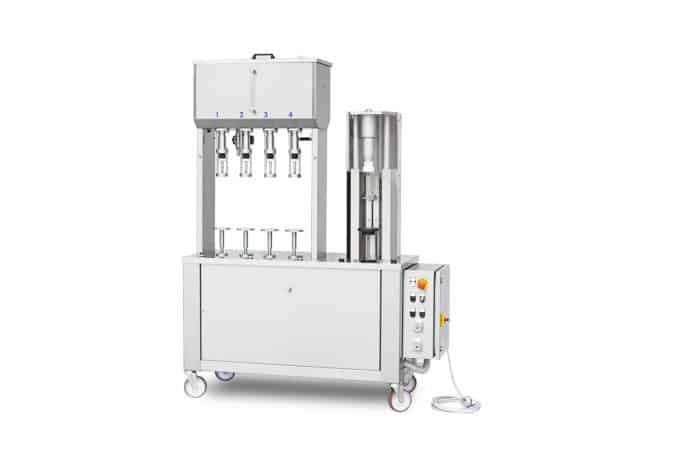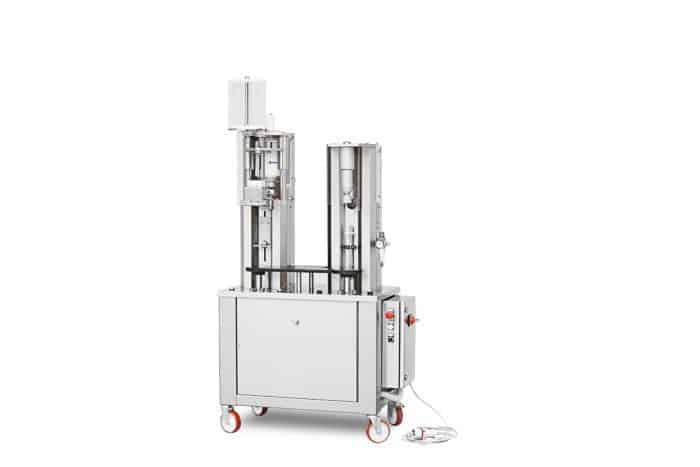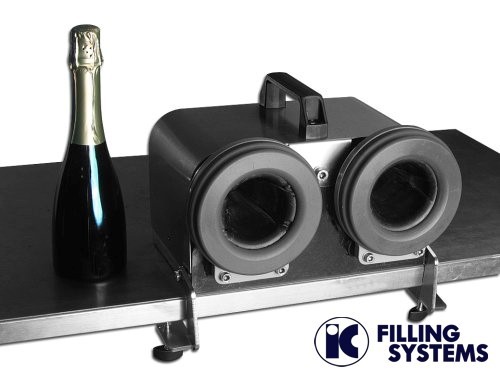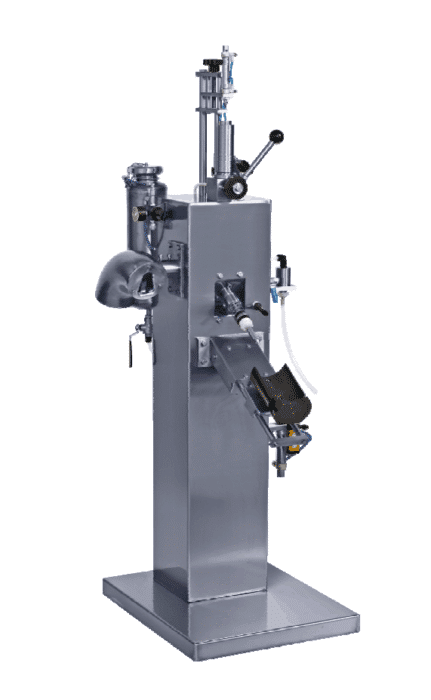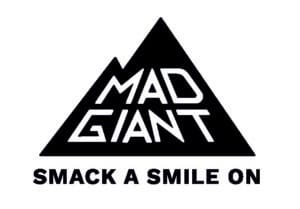“Méthode Champenoise” Champagne Bottling Equipment
IC Filling Systems are able to supply a complete set of equipment for the artisan producer of Champagne.
Semi automatic dégorgement processing of sparkling wines
Disgorgement is a wine word that pertains to Champagne and sparkling wines produced following the original process like “Brut” and “metodo classico” in Italy and Cava in Spain.
- Have you ever seen a notice on the back label of some bottles of Champagne saying "disgorged on X date"? Do you know what this means? And why do some bottles carry the notice while others do not?
Disgorgement, or dégorgement in French, is a step in making Champagne and other bottle-fermented sparkling wines. After the second fermentation, the wine rests on the dead yeast cells (called "lees") for a period of time, usually a minimum of 15 months for NV Champagne and a minimum of 3 years for vintage dated Champagnes (though most producers age for much longer then the minimum). This is called ageing "sur lie", or on the lees. Disgorgement is the process of taking these dead lees or sediment out of the bottle, so that when we buy the Champagne or sparkling wine it is crystal clear.
Before the disgorgement step takes place the individual bottles are riddled (rotated regularly) with the bottle lying at an angle, so that the lees (sediment) accumulate and collect in the neck of the bottle. This makes for easier and more uniform removal.
Traditionally this was a manual process, but today it is automated. The neck of the bottle is placed in a solution of freezing brine, which freezes the lees into a sort of hard pellet. Once the bottle is opened, the pressure from the bubbles in the bottle push out the pellet of frozen sediment, after which the dosage is added and the wine is re-corked and packaged for sale.
The disgorgement date thus marks the date that the Champagne or sparkling wine completed its production cycle. It is not an indication of vintage or a sell by date!
The whole idea of putting disgorgement dates on Champagne (and other sparkling wines) is that a particular 'batch' (or cuvée) of Champagne will not all be disgorged at the same time. The bottles disgorged first will taste slightly different from those disgorged later. If you have two bottles of seemingly the same Champagne without disgorgement dates, you really have no idea whether or not they are from the same disgorgement batch. Having the date of disgorgement stamped on the bottle helps the consumers know whether in fact they are comparing apples with apples. Or not!
Within the trade there are mixed views as to the usefulness of putting disgorgement dates on Champagne and sparkling wines. Those in favour feel that it helps consumers by giving them useful information. Those against feel that it is more likely to confuse the consumer, who might think it has something to do with the vintage, as many wine consumers won't know what disgorging actually means anyway, or that it might be indicating a 'sell-by' date, which it certainly is not indicating.
48 Pocket Neck Freezer
- Semi-hermetic Freezer Group
- Structure And Liquid Tank in AISI 304 Stainless Steel
- Rotary Table
- Adjustable Temperature Settings for the freezing brine With Digital Thermostat
- Circulation of freezing Liquid By Pump
- Manual Loading and unloading of Champagne Bottles
Champagne & Sparkling Wine Filler
- Machine base in stainless steel AISI 304 with large access doors
- All parts in contact with the liquid in stainless steel AISI 304
- Pneumatic lifting cylinders
- Device for adjusting the height of the tank in the change of format
- Tube for feeding product complete with pneumatic butterfly valve in stainless steel AISI 304 to control the flow of liquid in the tank
- Control of liquid in the tank by means of level sensors and relays
- Socket feed pump with control panel
- Filling valves easily removable for cleaning and maintenance
- Electrical system performed according to international safety standards with low voltage controls contained in stainless steel box
- Fill obtained by pure gravity
Champagne Crown Capper
- For initial capping prior to dégorgement
- Pneumatic descending head
- Manual format change
- Push button operation
Champagne Mushroom Corker / Cager
Mushroom Corker
- Closing head with bronze trolley
- Closing with tempered and rectified stainless steel jaws EM 304 ISOPLAST, easy to disassemble for cleaning and maintenance
- Pneumatic lifting of bottles
- Manual change of format
- Manual switch operation
Wire Hooder
- Pneumatic lifting of bottle
- Manual change format with spacers
- Manual wirehood distribution
- Pneumatic rolling wire cage
- Manual switch operation
Degorging & Dosing System
- Structure entirely made of stainless steel.
- Device for the operation of disgorging.
- Tank for the liqueur equipped with compressed air inlet (CO2 or Nitrogen) and manometer for pressure control.
- Device for bottle placement to control the flow of inbound Liqueur: this device is designed to accommodate both bottle formats workable.
- Three-way valve, with manual control, equipped with the device for adjusting the dose of liqueur into the bottles.
- Placement of bottle/tank of wine for the operation of levelling.
- Valve with manual lever for controlling the phase of levelling.
More about the process of making Champagne
Champagnisation is the long-awaited moment when all the skills and savoir-faire of the winemaker come into their own. Still wine produced by alcoholic fermentation is about to become effervescent —an all-important process that is specific to the Méthode Champenoise. This is the name given to that combination of age-old skills and minute attention to detail that so perfectly captures the Champagne region and its namesake beverage.
The French term tirage refers to drawing off the blended wines into bottles ready for a second alcoholic fermentation. Called the prise de mousse (literally ’capturing the froth’), this is the stage when the wine starts to bubble as a result of the carbon dioxide given off in the process. To kick-start second fermentation, the winemaker prepares a liqueur de tirage — still Champagne (vins clairs) mixed with a small quantity of sugar (see below) and liquid cultures of active wine yeast strains (ferments de tirage).
It should be noted that before Louis Pasteur’s revolutionary discovery, the addition of the liqueur de tirage was a rather ad hoc process that invariably resulted in broken bottles (up to 80% in 1828). This was not helped by the fact that glass at the time was hand-blown and bottles varied widely in quality. It was not until the early 19th Century that advances in bottle technology removed much of the uncertainty from second fermentation.
These days the addition of the liqueur de tirage is precisely calculated to produce an increase in pressure of 6 kg/cm2 by the end of fermentation. This corresponds to 24 grams of sugar per litre of blended wine, using a liqueur de tirage containing 500-625 grams of sugar (rock candy) per litre.
At one time, there used to be a lightly sparkling version of Champagne, "Champagne Crémant", which contained half this amount of sugar (12 grams instead of 24 grams), with half the amount of pressure as a result.
The liquid yeast cultures in the liqueur de tirage must include one of the three strains of Saccharomyces cerevisiae used in primary alcoholic fermentation — specially selected strains of dry yeast, with particular organoleptic qualities plus the ability to trigger the prise de mousse.
The yeasts are brought back to life in a mixture of still wine, water, sugar and diammonium phosphate. The wine serves to feed the yeast while the water, present in very small quantities, prevents the alcohol level from exceeding 11°-12°. The sugar meanwhile provides a source of carbon and fermentable matter, and the diammonium phosphate provides the nitrates necessary for cell growth.
The production of these yeast cultures lies at the heart of the "Champagnisation" process. In those rare cases where they fall short of the mark, secondary fermentation is ineffective and the wine must be returned to the vat — what French winemakers call a remise en cercles or "return to hoops" (a reference to the hoops around a wooden barrel).
To encourage yeast activity, the winemaker uses state-of-the art technology: fermenting bins, equipped with powerful mixing paddles, temperature control and oxygen injection systems.
Yeast multiplication and conditioning — the stage in the course of which the yeast adapts to the environment of secondary fermentation — can take anything from four days to several weeks. The culture obtained contains some 40-80 million live yeast cells per millilitre of liquid. It is added at the bottling stage at a concentration of 3 litres liqueur per hectolitre of wine, producng an inoculation rate of 1.2-2.4 million live yeast cells per litre of wine.
Ten years ago yeast was simply considered a fermentation agent. Today, science has shown that yeast contains a world of possibilities: each different strain produces a range of flavours and aromas all of its own.
Riddling aids are also added just before bottling: natural and/or mineral adjuvants (tanins, bentonite, alginates) that help the dead yeast cells (lees) to clump, so they don’t stick to the sides of the bottle. The heavier the deposit, the more easily it slides into the bottle neck.
The last stage before final bottling is to mix everything thoroughly in a tank — the blended wine, the liqueur de tirage containing the yeast culture and the riddling aids.
At the end of this process, the wine is bottled. Once filled, a standard Champagne bottle is sealed with a bidule: a hollow plastic cylinder designed to hold the residue of yeast that collects in the course of riddling. Held in place by a metal crown cap, the bidule, like its natural cork predecessor, prevents loss of pressure while still allowing for that slow, controlled oxidation so essential to the success of second fermentation.
By law, Champagne wines may not be bottled until the January following the harvest. Bottling can take anything from a few days to eight months depending on the size of House and the bottling facilities available.

"I have absolutely no qualms in recommending IC Filling Systems as a good and reputable company to deal with."
- Jim Quigley, Bottling Manager, Inver House Distillers.
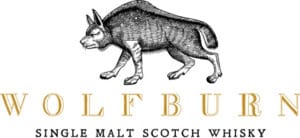
“IC Filling Systems provided our first bottle line that never let us down despite the incredible work load it was asked to perform. As more equipment arrives to further reinforce and advance not just the Mk2 bottle line but the business as a whole, IC Filling Systems will remain our partner of choice. Reliable, consistent and robust.”
- Iain Kerr, Wolfburn Distillery
![]()
"IC Filling Systems installed a new 7,000bph 20-20-5 Neck Handling PET Filler which we are extremely satisfied with. We were provided with excellent customer support from start to finish as well as being provided with a dedicated project engineer to assist with the whole process. Thanks to all the team at IC Filling Systems."
"Purchased a beer filter, 2 head keg filler and 551 bottle filler. We have received great support and our machines are running very well."
- Eben Uys, The Mad Brew Master, Mad Giant, South Africa
"We have worked with a whole host of people since we started in 2017, and by far, the best people we have worked with during that time was Forysths, and I never thought we would work with someone that matched them, but IC Filling Systems did, and in particular, Alessandro was a joy to work with, he was brilliant!! So good to learn from and a great teacher. He is an asset to the company! We would definitely recommend IC Filling Systems to whoever might ask."
- Michael Morrison, Managing Director, Isle of Barra Distillers
Checking...
Retry »
Sending message...
Send us your enquiry today...
Tell us what you need, and we'll respond promptly.

For detailed information
Contact our Sales Director Marco Solferini by calling
+39 0141 162 0091 or +39 0141 74166 (Italy)
+44 1865 520 083 (UK)
Alternatively request
a quotation
Can’t find what you’re looking for?
Search this site...

